CFOs have an incredibly hard job when it comes to helping IT manage a budget. Let’s face it, there have been books written (like ‘Does IT Matter, by Carr) that discuss the value of all those blinking lights in the data center.
The reality is that some of those blinking lights do matter and others are a financial sink hole. Over the past 3 years storage has crept up to be one of the higher cost items in the data center and storage is a lot like death and taxes, it just IS. It is really the applications that drive revenue for your company and these applications just keep generating data which in 45 days will most likely be obsolete – well as least 90% of it. The trick is which 90% and because no one can really tell which 90% you have to keep all of it.
Now let’s switch to technology for a moment. For sure CFO’s have heard all the technology buzz words around IT. Vendors today realize that they have to meet high ROI / TCO demands in order to effectively sell to customers, especially in the storage world. One of these technologies is data deduplication. On the surface (just by nature of its name) it seems like the defacto standard for all storage growth problems – just ‘deduplicate’ your data and all your storage issues go away. Well, I am here to tell you ‘Don’t Get Duped by Dedupe’. It may be the new fancy technology word for storage vendors, but when all you have is a hammer, everything looks like a nail.
What I mean by this is that just because ‘deduplication’ is today’s storage buzz word, it is not a solution for all data growth challenges, especially for primary storage. Compression, especially when done right – real time and random access, is the best solution for stemming the tide of primary storage growth.
CFO’s need to understand that the hardest thing to do when solving a problem in IT that it is not just about finding a low cost solution to the challenge at hand, but finding a solution that integrates will all of IT’s existing processes. If the solution does not integrate, then it could actually cost more over the long run.
This is the key benefit to the Storwize technology. Storwize has cracked the code on compression such that it is both real-time and random access. Real-time, random access compression, when deployed in front of your storage can dramatically reduce your storage foot print without:
- Degrading performance
- Changing your application
- Changing any of your downstream processes
Real-time, random access compression transparently integrates into your existing infrastructure and can post pone additional storage purchases for years.
Back to the business challenge of not knowing what 90% of the data you have in your environment you must keep. It would be easy to just delete the data but because no one know what data will be necessary in the future, and access to this data becomes critical when it is needed, it forces IT to keep more of it on-line. So if it must be kept ‘on-line’, it makes sense to store it in the most efficient way possible that doesn’t create any additional data management overhead. Deploying Storwize (real-time, random access compression) can reduce capacity anywhere between 50 to 90 percent, have no impact to performance and fit seamlessly into the IT infrastructure.
Additionally, when using Storwize compression, IT will replicate less data saving in bandwidth and replicated disk costs as well as backup less data, making backups faster and requiring less capacity of tapes, disk or even deduplicated disk. Not only is there tremendous CapEx savings there is also tremendous OpEx savings.
Once compressed, because the data never again needs to be decompressed on the disk, the savings is tremendous. Over time, once the array is full and new storage capacity is required, IT can purchase less physical storage along with Storwize resulting in lower overall storage infrastructure spend. Because you are buying less storage, you also require less foot print to store your data and less power and cooling for your storage. Finally you will also pay less maintenance for your storage.
The table below shows Storwize compression being implemented into an existing storage environment. The graph for primary (which is also equivalent for replication) and the graph for power and cooling show (in red) the capacity and cost had Storwize and storage been purchased together. (For more information go to www.storwize.com/roi to create an ROI for your environment.) You can also see our assumptions.
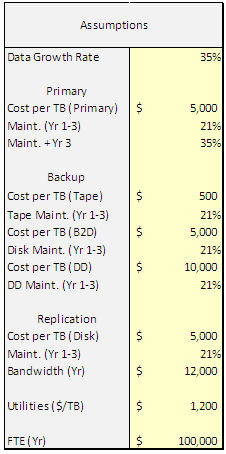
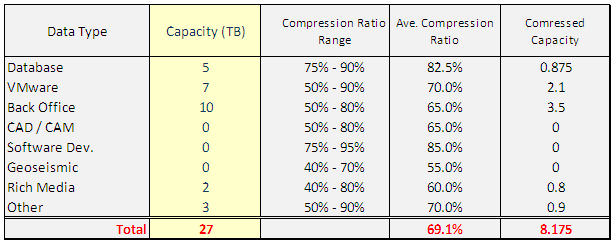
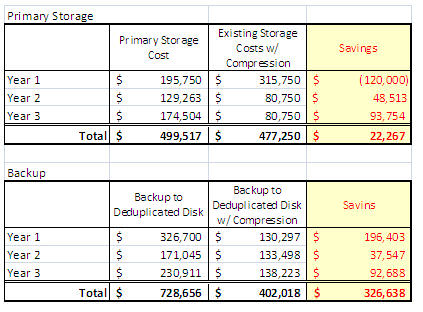
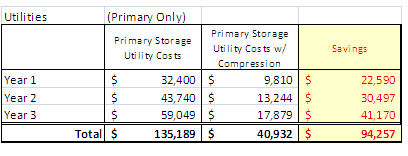
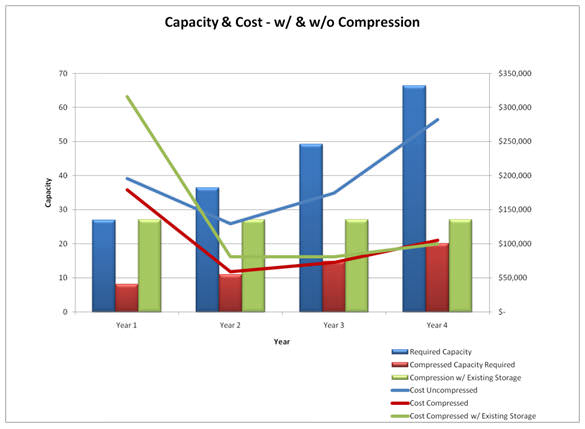
CFO’s you have your work cut out for you, but don’t let the latest buzz words become the answer to your data storage problems. Sometimes go old technology like compression, utilized in a revolutionary way can drive tremendous value.